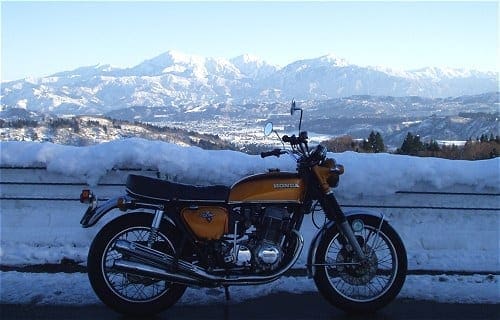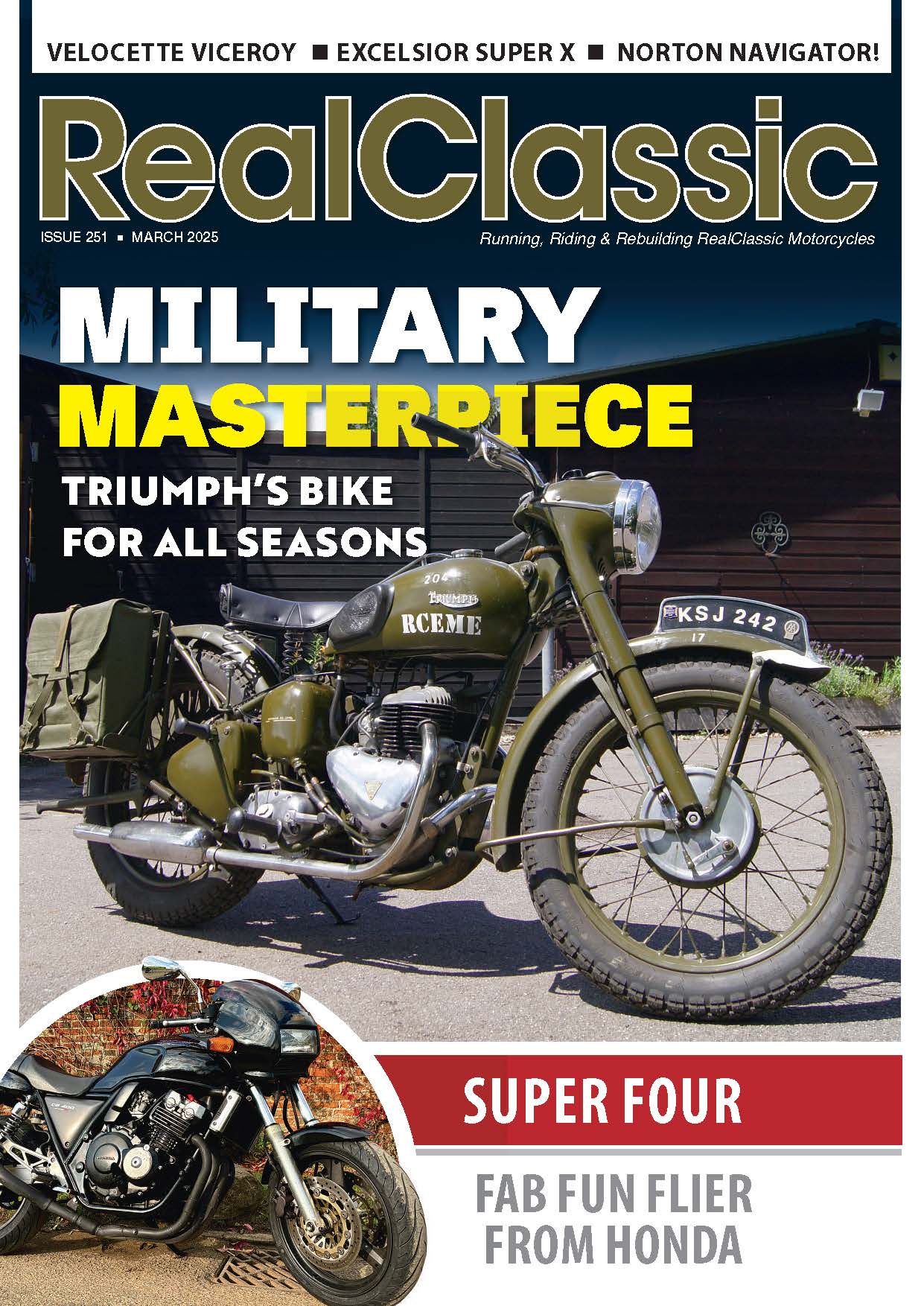
Ever wondered why some people seem to revel in riding their classic bikes in winter, while others just head for the nearest bar – or the nearest ditch. Martin Gelder has some top tips…
This isn’t intended to be one of those “Riding Guides” that many of the ‘proper’ magazines seem to love so much at this time of year; we’re all old dogs on here and none of the tricks I’m going to mention are particularly new.
Instead, I just thought it might be interesting to give some thought to riding in the weather and road conditions we’re experiencing at the moment. Readers in Australia are asked to spend the next few paragraphs thanking their lucky stars that they won’t be getting stuck behind a gritting lorry on the way home tonight.
Shepherds Warning
Check the weather forecast before setting off, so you know what to expect. Below 3 degrees Celcius and it might be frosty, below 0 degrees and it might well be icy. Even if the sun is out, there could still be black ice patches lurking in dips and shadows, so know your enemy and be prepared.
The Right Tool for the Job
The basic bike checks become more important when conditions are bad. Are all the cables properly lubed? Grabby controls are the last thing you need when trying to ride smoothly, and a bit too much moisture in the wrong place can cause a clutch or – gulp – brake cable to freeze in position Check that all the lights are working and that their lenses are clean, that the tyres are at the right pressures and that the bike will tick over happily on its own while you warm your hands on the cylinder head at traffic lights.
CB750 Four, Nigata, Japan
Wrap Up Warm
If you’re thinking about how cold you are, you’re not thinking about what’s going on around you while you’re riding. Use plenty of thin layers to trap the warmth close to your body, and then something a bit bulkier over the top to keep out the wind and the rain. If you’ve never tried proper mountaineering-style “base layer” thermals, you’re in for a treat; they manage to keep you warm while you’re sat on the bike yet avoid drenching you in sweat during the short walk from house to shed and for the seventeen kicks it takes to start the bike.
Don’t wear so many layers that you can’t can’t move easily; if your over-trousers bunch up at the knees or your jacket bunches at the elbows, you’ll restrict the blood flow to your feet or hands and they’ll get cold. The same goes for wearing so many pairs of socks that you’re toes can’t move inside your boots. And make sure you have enough freedom of movement to be able to look over your shoulder without twisting your whole body round.
Choice of helmet / googles / visor is a very personal thing but whatever you use, make sure it isn’t going to mist up the moment your speed drops below 50mph. Gloves are another matter of personal preference; some prefer mittens or lobster claws, others go for heated grips or handlebar muffs.
Setting Off
Engines need to warm up, and so do tyres and suspension units. For the first few miles of a really cold ride the oil in the suspension units will be like treacle, and this will reduce your bike’s roadholding and might also affect the steering response. Take it easy and feel for the messages the bike is giving you; you’ll know when it’s warmed up properly.
Better Off Without Us
Left to its own devices, a moving motorcycle will quite happily keep going in a straight line until its speed drops to nearly walking pace. Even on a greasy and horrible winter road with a coating of leaf mulch, diesel, frost, snow or even ice.
It’s the rider that makes a bike fall over, generally for one of three reasons; braking too hard, leaning over too far, or accelerating too hard.
|
Braking Too Hard Brake too hard, too quickly and you’ll lock a wheel. So brake smoothly, brake gently and – most importantly – brake early. Keep your wits about you and your anticipation skills honed and you can probably get away with just rolling the throttle closed when you need to lose speed. If you do need to brake hard, build up the pull on the lever and press on the pedal smoothly, and be prepared to release and then re-apply either brake if a wheel threatens to lock up. Rear wheel lock-ups are relatively easy to control by just releasing the rear brake but a locked front wheel requires very quick reactions. What typically happens is that the front wheel slides in a straight line for a few feet when it locks up, and then the bars snap to one side or the other, and you fall off. Ouch. If you feel the front wheel locking – and you should be expecting it to go if the road is slippy – and you can get off the brake and relax your hold on the bars quickly enough, you can save it. Quite often, you’ll hear the front wheel sliding before you feel it though the bars, and you’ll notice for a split second that you’re not slowing down as much as you should be. That’s the point to let go of the front brake. Better to use observation and anticipation to avoid the need to brake sharply in the first place, though. |
Stay in the shed and rebuild one of these eBay project bikes instead… |
Leaning Over Too Far
On a winter road in the UK, one that’s coated with diesel spills, salt residue and general slime, you might not be able to lean over very much at all. The only way to judge how much grip you have is to feel for what the tyres are telling you. If the handlebars feel easier to turn than normal as you enter a bend, or if the bike runs a little wider than you expect on the way out of a bend, it’s probably because the road is slippier than usual.
If you go from upright to leaning over gently, smoothly and progressively, you should be able to feel for the warning signs of a ‘leaning over too far’ slide before you get into too much trouble.
If you are leaning over too far and have the throttle slightly open, the rear wheel will be the one to start to let go first. Gently close the throttle and pick the bike up slightly and you should be okay. If you’re leaning over too far while trailing the front brake, it’ll be the front wheel that lets go first. Font wheel slides are harder to save than front wheel lock-ups, so always try to corner on a very slightly open throttle.
Better, in fact, to use observation and anticipation to avoid the need to lean over too far in the first place.
Accelerating Too Hard
This is usually more of a problem for MotoGP riders and trackday heroes than for winter riders on classics, but it’s still quite easy to overcome the grip available at the rear wheel by using too much power too clumsily. In the same way that you should be anticipating a locked wheel while braking, you should expect the back wheel to break away if you accelerate too hard. Smooth and gentle use of the throttle are the answer, and feeling for what the bike is telling you.

A Pub, Teesdale, UK.
Observation and Anticipation
The best way to stay out of trouble is to avoid getting into it in the first place. Watch where you’re going, keep an eye on other road users, plan ahead and try and keep your riding smooth and gentle. And if you’re starting to feel the cold creeping in, stop for a break. Get off the bike, have a hot drink and something to eat and move around a bit to get the circulation going.
Winter bimbling can be intensely enjoyable and extremely rewarding if you set off in the right frame of mind.
Don’t Try This at Home
The worst time to try and hone your winter riding skills is in winter, on the roads, while riding your pride and joy. Many of the most confident road riders and all of the best road racers have spent some time riding off road. Even the most upright of road riders will learn more about front and rear wheel grip in an afternoon of off-roading than in a year on tarmac. And the skills picked up transfer directly from muddy field to greasy road. If you get the chance, give it a go.
Got any of your own winter riding tips?

Archie’s Enfield
Slip slidin’ away
You know the nearer your destination
The more you’re slip slidin’ away
Paul Simon




